2025-12-29 11:00:00
This year I bought more shirts than ever. Mostly because I decided to go to as many concerts as I possibly could.
With the year coming to a close, I thought this would be a good moment to look back at the shirts I collected throughout the year and see the story that they tell. So here it is, my 2025 retrospective through shirts:
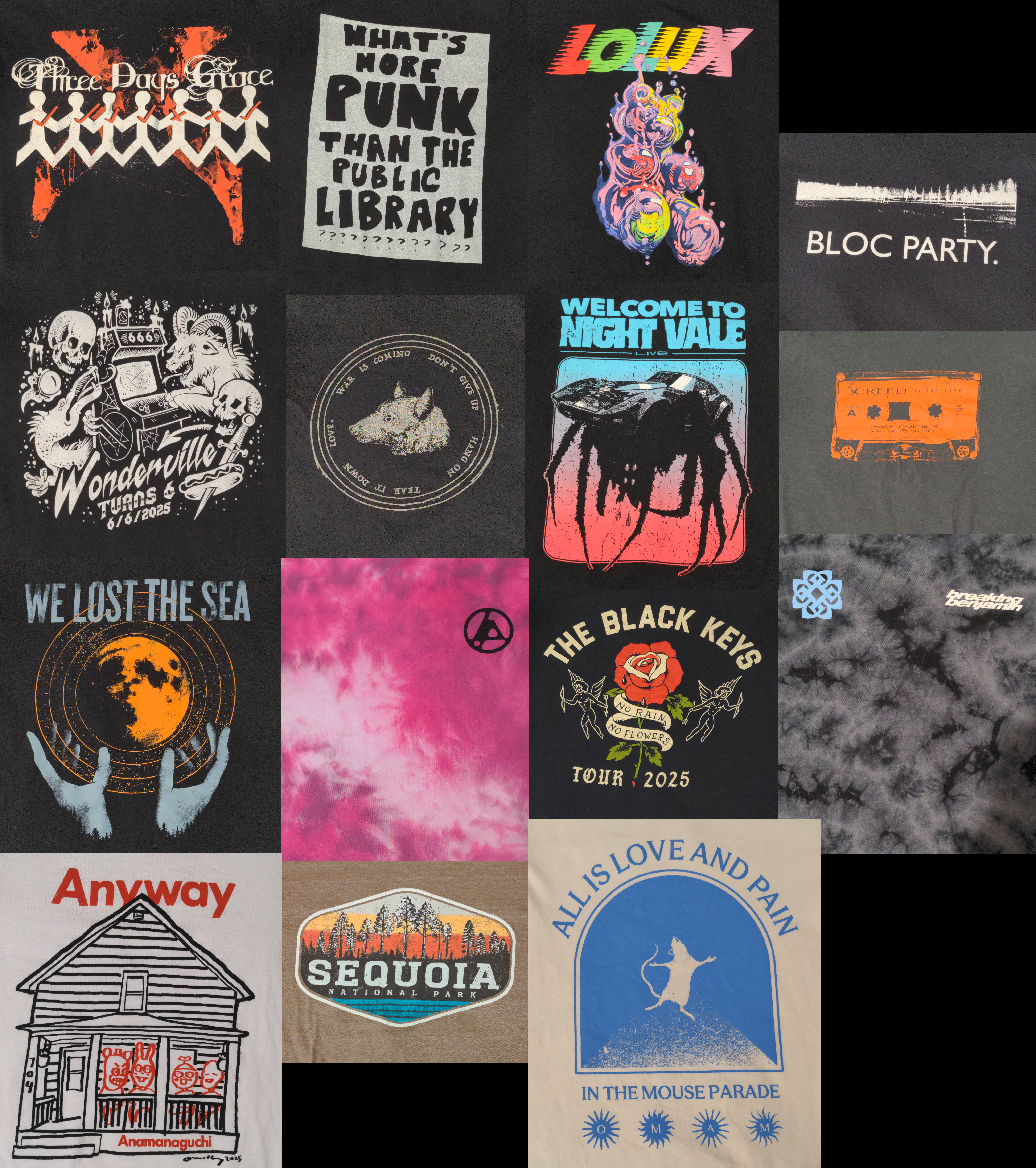
From top left to bottom right:
2025-12-01 11:00:00
Slightly late for November, but better late than never!
As November rolled by, and the Christmas mood took over, I put on an old school Christmas songs playlist on YouTube.
Many of the songs I was hearing for the first time. A few of my favorites were Carol of the Bells, The First Noel and Darlene Love - Christmas (Baby Please Come Home).
But my favorite of all has to be "Do You Hear What I Hear?", particularly the version sung by Andy Williams, so that's my pick for the month:
2025-10-28 11:00:00
This month I went on a two week long road trip through California with a friend. We sailed on Lake Tahoe, walked over sand dunes in Death Valley, and hiked between the mountains in Yosemite Valley. We saw the oldest trees on Earth at the Ancient Bristlecone Pine Forest, and also the largest trees, at Sequoia National Park, through a mysterious fog.
We listened to many songs throughout the trip, but there was one that popped up and seemingly immediately won my friend over, as he kept putting it back on time and again. It is indeed a beautiful song, and will forever carry the memory of this amazing trip. It is my pick for this month:
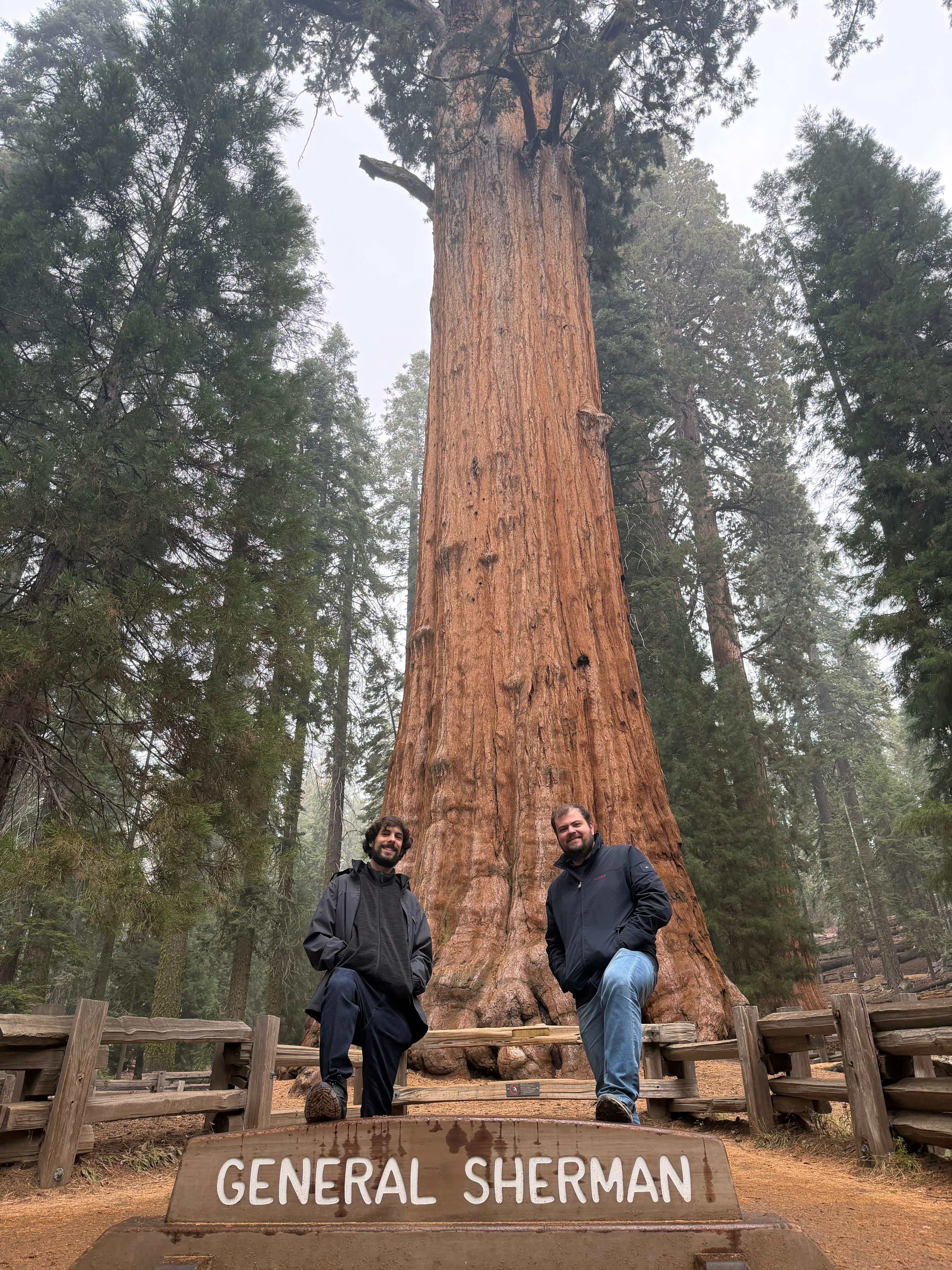
2025-09-30 11:00:00
My pick for song of the month this time around is a track that played at Spectacle Theater before the movie started (the movie was Mirage Men (2013), by the way). The lyrics are very poetic, and the instrumentation has this eerie and underground feel to it. It's a great song on its own, but it was elevated by being played at one of my favorite places in NYC and perfectly matching the vibe.
Check it out:
2025-09-04 11:00:00
It's been almost two years since I posted the "Collecting pins" post! It's time I shared an update.
Somewhere along the way I decided to get more organized and started a spreadsheet to track all the details about my pin collection (has this crossed the line to the unhealthy hobby territory yet?). The main thing I wanted to have was a clear history of the collection: when, where and how was each pin added to the collection. And after spending a lot of time filling in the blanks, today I can finally share it!
So here it is, my current pin collection, with 128 pins and filling up two and a half display cases, summarized in three images and a table:
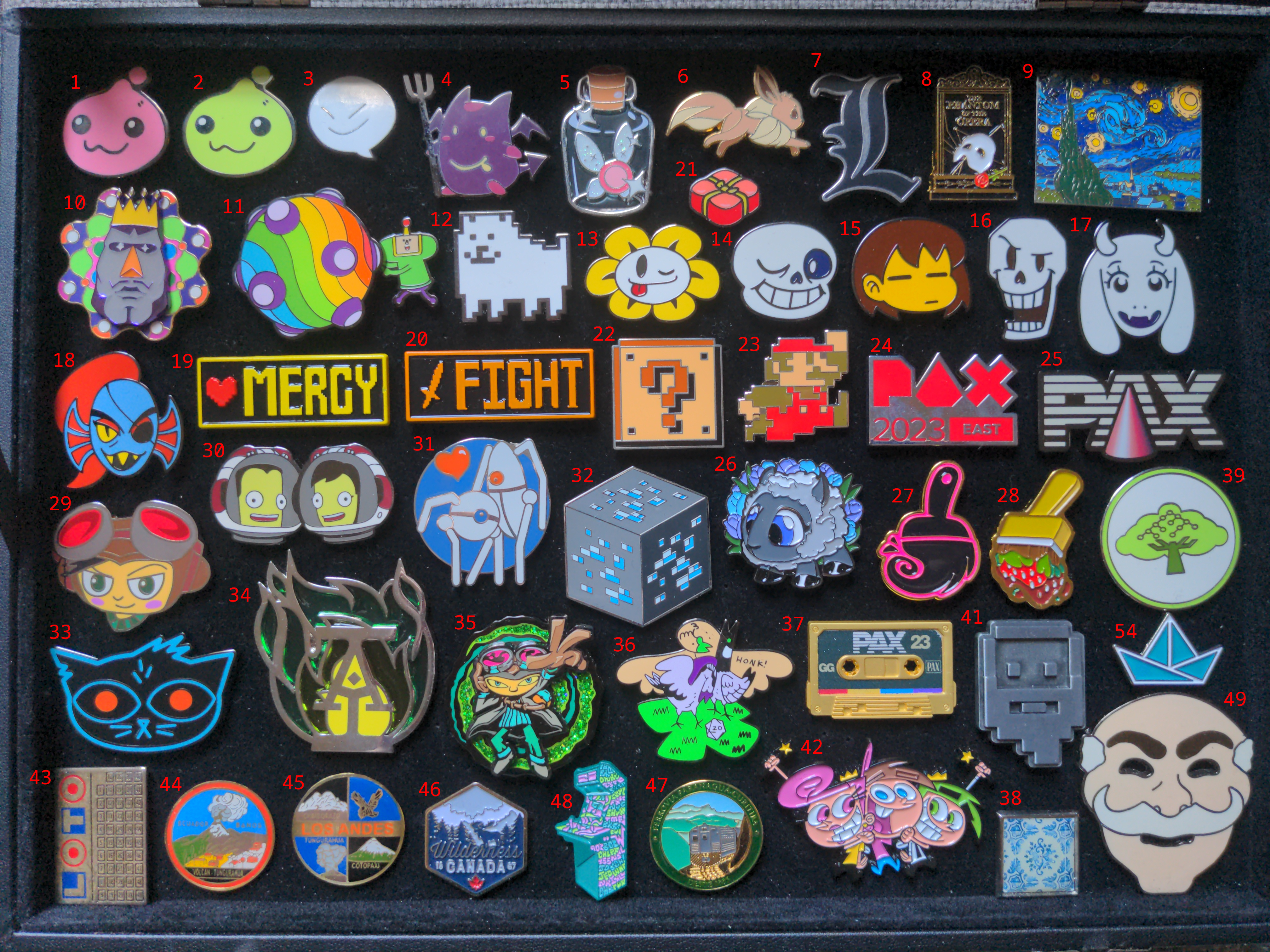
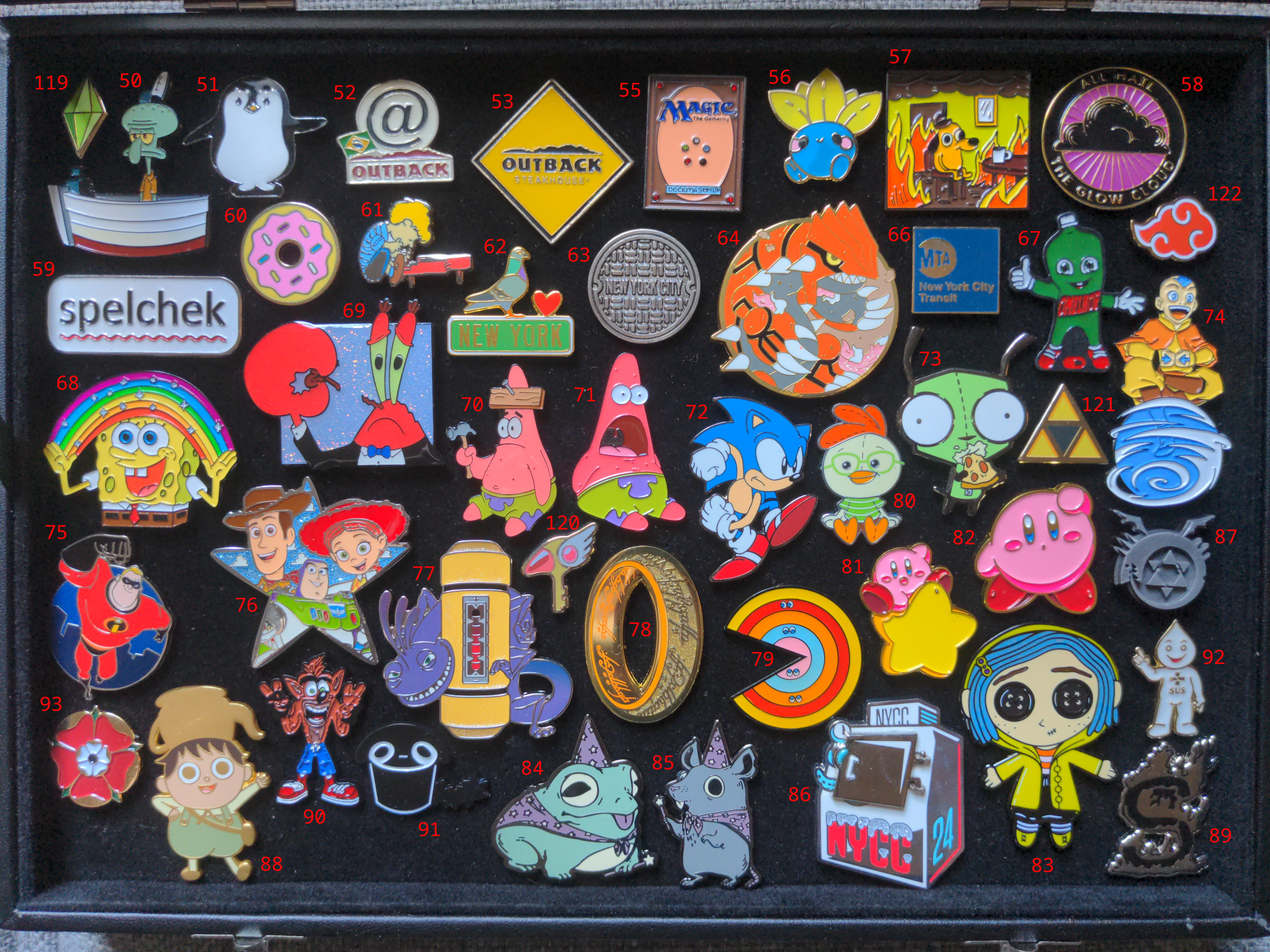
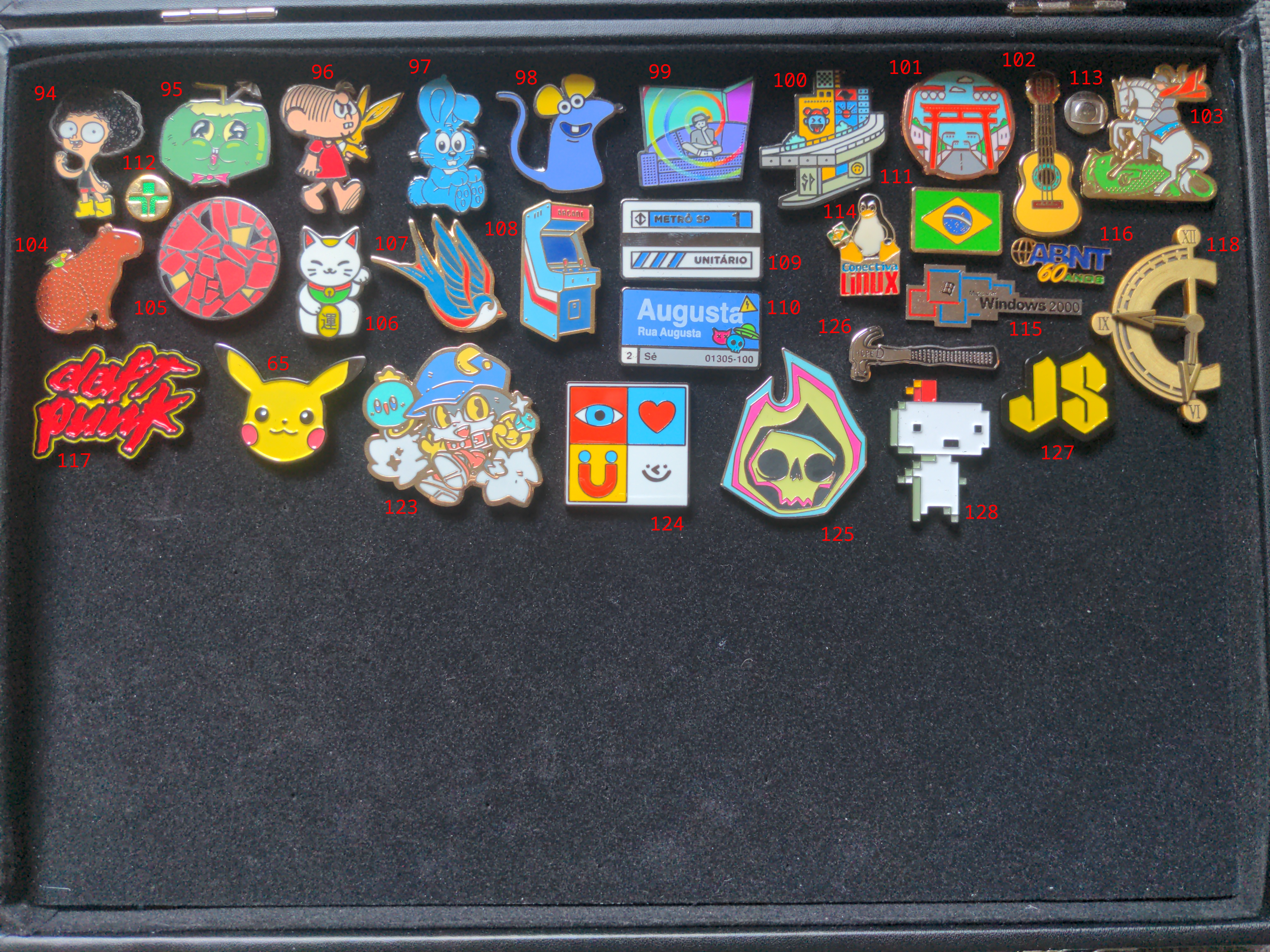
| No. | Name | When | Where | How |
|---|---|---|---|---|
| 1 | Poring — Ragnarok Online | 2022-12-01 | Online | Purchase |
| 2 | Poporing — Ragnarok Online | 2022-12-01 | Online | Purchase |
| 3 | /Gg Emote — Ragnarok Online | 2022-12-16 | Online | Purchase |
| 4 | Deviruchi — Ragnarok Online | 2022-12-16 | Online | Purchase |
| 5 | Fairy Bottle — Zelda | 2022-12-16 | Online | Purchase |
| 6 | Eevee — Pokémon | 2022-12-21 | Online | Purchase |
| 7 | L — Death Note | 2023-02-08 | Geek store in Antwerp, Belgium | Purchase |
| 8 | Phantom Of The Opera | 2023-02-13 | Phantom of the Opera show at Majestic Theatre in NYC | Purchase |
| 9 | Van Gogh's The Starry Night | 2023-03-11 | MoMA in NYC | Purchase |
| 10 | King — Katamari Damacy | 2023-03-23 | Fangamer stand at PAX East 23 | Purchase |
| 11 | Prince & Katamari — Katamari Damacy | 2023-03-23 | Fangamer stand at PAX East 23 | Purchase |
| 12 | Annoying Dog — Undertale | 2023-03-23 | Fangamer stand at PAX East 23 | Purchase |
| 13 | Flowey — Undertale | 2023-03-23 | Fangamer stand at PAX East 23 | Purchase |
| 14 | Sans — Undertale | 2023-03-23 | Fangamer stand at PAX East 23 | Purchase |
| 15 | Frisk — Undertale | 2023-03-23 | Fangamer stand at PAX East 23 | Purchase |
| 16 | Papyrus — Undertale | 2023-03-23 | Fangamer stand at PAX East 23 | Purchase |
| 17 | Toriel — Undertale | 2023-03-23 | Fangamer stand at PAX East 23 | Purchase |
| 18 | Undyne — Undertale | 2023-03-23 | Fangamer stand at PAX East 23 | Purchase |
| 19 | Mercy Button — Undertale | 2023-03-23 | Fangamer stand at PAX East 23 | Purchase |
| 20 | Fight Button — Undertale | 2023-03-23 | Fangamer stand at PAX East 23 | Purchase |
| 21 | Junimo Package — Stardew Valley | 2023-03-23 | Fangamer stand at PAX East 23 | Purchase |
| 22 | ? Block — Super Mario Bros. | 2023-03-23 | PAX merch stand at PAX East 23 | Purchase |
| 23 | Mario — Super Mario Bros. | 2023-03-23 | PAX merch stand at PAX East 23 | Purchase |
| 24 | East 2023 Logo | 2023-03-23 | PAX merch stand at PAX East 23 | Purchase |
| 25 | PAX East VHS | 2023-03-23 | PAX merch stand at PAX East 23 | Purchase |
| 26 | Babaa — Neopets | 2023-03-24 | Geekify stand at PAX East 23 | Purchase |
| 27 | Wraith Paintbrush — Neopets | 2023-03-24 | Geekify stand at PAX East 23 | Purchase |
| 28 | Strawberry Fields Forever Paintbrush — Neopets | 2023-03-24 | Geekify stand at PAX East 23 | Purchase |
| 29 | Raz — Psychonauts | 2023-03-24..26 | Trading hall at PAX East 23 | Gift |
| 30 | Kerbal Space Program | 2023-03-24..26 | Trading hall at PAX East 23 | Gift |
| 31 | Atlas And P-Body — Portal 2 | 2023-03-24..26 | Trading hall at PAX East 23 | Trade |
| 32 | Diamond Ore Block — Minecraft | 2023-03-24..26 | Trading hall at PAX East 23 | Trade |
| 33 | Mae — Night In The Woods | 2023-03-24..26 | Finji stand at PAX East 23 | Purchase |
| 34 | Green Flame — Acquisitions Inc. | 2023-03-24..26 | Acquisitions Incorporated stand at PAX East 23 | Purchase |
| 35 | Psychokinetic Raz — Psychonauts 2 | 2023-03-24..26 | Fangamer stand at PAX East 23 | Purchase |
| 36 | Goose — Kickstarter | 2023-03-24..26 | Kickstarter stand at PAX East 23 | Reward |
| 37 | PAX Gold Mixtape | 2023-03-24..26 | Carnival wheel at Pinny Arcade booth at PAX East 23 | Reward |
| 38 | Portuguese Tile | 2023-05-06..07 | Portugal (Porto?) | Purchase |
| 39 | Software Freedom Conservancy's Logo | 2023-05-08..11 | Collabora Meetup in Portugal | Gift (from Padovan) |
| 40 | Collabora's Logo | 2023-05-08..11 | Collabora Meetup in Portugal | Gift (from Guy) |
| 41 | +Finely-Crafted Dwarven Pin+ — Dwarf Fortress | 2023-05-20 | Online | Purchase |
| 42 | Fairly Oddparents | 2023-06-06 | Online | Purchase |
| 43 | Loto | 2023-11-09..11 | Home in NYC | Gift (from Tony) |
| 44 | Ecuador | 2023-11-09..11 | Home in NYC | Gift (from Tony) |
| 45 | Los Andes | 2023-11-09..11 | Home in NYC | Gift (from Tony) |
| 46 | Canada Wilderness | 2023-11-09..11 | CN Tower in Toronto / Home in NYC | Gift (from Tony) |
| 47 | Paranaguá Train | 2023-11-09..11 | Home in NYC | Gift (from Tony) |
| 48 | Wonderville Arcade Machine | 2023-11-10 | Wonderville in NYC | Purchase |
| 49 | Mask — Mr. Robot | 2023-11-15 | Online | Purchase |
| 50 | Squidward At Work — Spongebob Squarepants | 2023-12-01 | Home in NYC | Gift (from Mom) |
| 51 | Penguin | 2023-12-01 | Home in NYC | Gift (from Mom) |
| 52 | Outback @ | 2023-12-03 (originally ~2010) | Home in São Paulo | Gift (from Mom) |
| 53 | Outback Steakhouse Sign | 2023-12-03 (originally ~2010) | Home in São Paulo | Gift (from Mom) |
| 54 | Paper Boat | 2023-12-09..15 | Cruise to northeast of Brazil | Purchase |
| 55 | Magic The Gathering Card Back | 2023-12-15..2024-01-27 | SoGo Plaza Shopping in São Paulo | Purchase |
| 56 | Odish — Pokémon | 2023-12-15..2024-01-27 | SoGo Plaza Shopping in São Paulo | Purchase |
| 57 | This Is Fine (First Panel) | 2024-05-29 | Online | Purchase |
| 58 | All Hail The Glow Cloud — Welcome to Night Vale | 2024-05-29 | Online | Purchase |
| 59 | Spelcheck | 2024-05-29 | Online | Purchase |
| 60 | Donut | 2024-06-01..2024-08-01 | Gift shop at Bryant Park | Purchase |
| 61 | Schroeder — Peanuts | 2024-06-01..2024-08-01 | Newtown HQ store in NYC | Purchase |
| 62 | New York Pidgeon | 2024-06-01..2024-08-01 | Newtown HQ store in NYC | Purchase |
| 63 | New York Sewer | 2024-06-01..2024-08-01 | Newtown HQ store in NYC | Purchase |
| 64 | Groundon — Pokémon | 2024-06-01..2024-08-01 | Say Cheese store in NYC | Purchase |
| 65 | Pikachu — Pokémon | 2024-06-01..2024-08-01 | Say Cheese store in NYC | Purchase |
| 66 | MTA Logo | 2024-08-16 | New York Transit Museum | Purchase |
| 67 | Dollyinho | 2024-09-21 | Vienna, Austria | Gift (from Tony) |
| 68 | Imagination! — Spongebob Squarepants | 2024-10-17 | Zen Monkey Studios stand at New York Comic Con 2024 | Purchase |
| 69 | Mr. Krabs' World's Smallest Violin — Spongebob Squarepants | 2024-10-17 | Zen Monkey Studios stand at New York Comic Con 2024 | Purchase |
| 70 | Nail in Head Patrick — Spongebob Squarepants | 2024-10-17 | Zen Monkey Studios stand at New York Comic Con 2024 | Purchase |
| 71 | Shocked Patrick — Spongebob Squarepants | 2024-10-17 | Zen Monkey Studios stand at New York Comic Con 2024 | Purchase |
| 72 | Speedy Sonic — Classic Sonic The Hedgehog | 2024-10-17 | Zen Monkey Studios stand at New York Comic Con 2024 | Purchase |
| 73 | Pizza Slurpin' Gir — Invader Zim | 2024-10-17 | Zen Monkey Studios stand at New York Comic Con 2024 | Purchase |
| 74 | Aang On Air Scooter — Avatar: The Last Airbender | 2024-10-17 | Zen Monkey Studios stand at New York Comic Con 2024 | Purchase |
| 75 | Mr. Incredible — The Incredibles | 2024-10-17 | Disney pin trading event at New York Comic Con 2024 | Trade |
| 76 | Woody, Buzz Lightyear & Jessie — Toy Story | 2024-10-17 | Pins stand at New York Comic Con 2024 | Purchase |
| 77 | Randall Boggs with Scream Canister — Monsters Inc. | 2024-10-17 | Pins stand at New York Comic Con 2024 | Purchase |
| 78 | The One Ring — The Lord of the Rings | 2024-10-17 | Pins stand at New York Comic Con 2024 | Purchase |
| 79 | Pacman | 2024-10-17 | Pins stand at New York Comic Con 2024 | Purchase |
| 80 | Chicken Little | 2024-10-17 | Pins stand at New York Comic Con 2024 | Purchase |
| 81 | Warp Star Kirby | 2024-10-17 | Pins stand at New York Comic Con 2024 | Purchase |
| 82 | Kirby | 2024-10-17 | Pins stand at New York Comic Con 2024 | Purchase |
| 83 | Coraline | 2024-10-17 | Spooksieboo stand at New York Comic Con 2024 | Purchase |
| 84 | BFF Frog | 2024-10-17 | NYCC merch stand at New York Comic Con 2024 | Purchase |
| 85 | BFF Rat | 2024-10-17 | NYCC merch stand at New York Comic Con 2024 | Purchase |
| 86 | NYCC | 2024-10-17 | NYCC merch stand at New York Comic Con 2024 | Purchase |
| 87 | Ouroboros — Fullmetal Alchemist | 2024-10-26 | Online | Purchase |
| 88 | Greg — Over The Garden Wall | 2024-10-28 | Online | Purchase |
| 89 | Spectacle Logo | 2024-11-02 | Spectacle Theater in NYC | Purchase |
| 90 | Crash Bandicoot | 2024-12-10 | Uber ride headed to trampoline park in São Paulo | Gift (from Marianna) |
| 91 | Black Cat In Bucket | 2024-12-10 | Uber ride headed to trampoline park in São Paulo | Gift (from Marianna) |
| 92 | Zé Gotinha | 2025-01-12 | Tony’s home | Gift (from Tony) |
| 93 | Tudor Rose | 2025-01-18 | Tony’s home | Gift (from Tony) |
| 94 | Irmão Do Jorel | 2025-01-20 | Santa Hell store in Galeria do Rock in São Paulo | Purchase |
| 95 | Coco Mágico — Irmão do Jorel | 2025-01-20 | Santa Hell store in Galeria do Rock in São Paulo | Purchase |
| 96 | Mônica 1963 — Turma da Mônica | 2025-01-20 | Santa Hell store in Galeria do Rock in São Paulo | Purchase |
| 97 | Sansão — Turma da Mônica | 2025-01-20 | Santa Hell store in Galeria do Rock in São Paulo | Purchase |
| 98 | Ratinho — Castelo Rá Tim Bum | 2025-01-20 | Santa Hell store in Galeria do Rock in São Paulo | Purchase |
| 99 | Senta Que Lá Vem História — Castelo Rá Tim Bum | 2025-01-20 | Santa Hell store in Galeria do Rock in São Paulo | Purchase |
| 100 | Minhocão | 2025-01-20 | Santa Hell store in Galeria do Rock in São Paulo | Purchase |
| 101 | Liberdade | 2025-01-20 | Santa Hell store in Galeria do Rock in São Paulo | Purchase |
| 102 | Cavaquinho | 2025-01-20 | Santa Hell store in Galeria do Rock in São Paulo | Purchase |
| 103 | São Jorge | 2025-01-20 | Santa Hell store in Galeria do Rock in São Paulo | Purchase |
| 104 | Capivara | 2025-01-20 | Santa Hell store in Galeria do Rock in São Paulo | Purchase |
| 105 | Piso de Caquinho | 2025-01-20 | Santa Hell store in Galeria do Rock in São Paulo | Purchase |
| 106 | Lucky Cat | 2025-01-30 | Online | Purchase |
| 107 | Andorinha | 2025-01-30 | Online | Purchase |
| 108 | Fliperama | 2025-01-30 | Online | Purchase |
| 109 | Metrô SP | 2025-01-30 | Online | Purchase |
| 110 | Rua Augusta | 2025-01-30 | Online | Purchase |
| 111 | Bandeira Brasil | 2025-01-30 | Online | Purchase |
| 112 | Tv Cultura | 2025-02-02 | Street fair close to Av. Paulista in São Paulo | Purchase |
| 113 | Globo | 2025-02-02 | Street fair close to Av. Paulista in São Paulo | Purchase |
| 114 | Linux Conectiva | 2025-02-02 | Street fair close to Av. Paulista in São Paulo | Purchase |
| 115 | Windows 2000 | 2025-02-02 | Street fair close to Av. Paulista in São Paulo | Purchase |
| 116 | ABNT | 2025-02-02 | Street fair close to Av. Paulista in São Paulo | Purchase |
| 117 | Daft Punk | 2025-03-18 | Online | Purchase |
| 118 | Chrono Trigger | 2025-03-27 | Online | Purchase |
| 119 | Plumbob — The Sims | 2025-03-28 | Online | Purchase |
| 120 | Cardcaptor Sealing Key — Cardcaptor Sakura | 2025-03-28 | Online | Purchase |
| 121 | Triforce — Zelda | 2025-03-28 | Online | Purchase |
| 122 | Akatsuki — Naruto | 2025-03-28 | Online | Purchase |
| 123 | Klonoa | 2025-03-28 | Online | Purchase |
| 124 | Love From Wilmot — Wilmot’s Warehouse | 2025-04-26 | Online | Purchase |
| 125 | Usual June | 2025-04-26 | Online | Purchase |
| 126 | Hope Hammer — Godspeed You! Black Emperor | 2025-06-27 | Godspeed You Black Emperor show at District Music Hall in Norwalk, CT | Purchase |
| 127 | Javascript | 2025-08-07 | Astoria Tech Meetup meeting | Gift (from Tea) |
| 128 | Gomez — FEZ | 2025-08-09 | Long Island Retro Gaming Expo at Cradle of Aviation Museum | Purchase |
[*] The Collabora's Logo pin is not in the display since it's magnetic, but you can see it in the previous blog post.
The full spreadsheet wouldn't fit comfortably in this page, so the table above contains only the main columns. You can download the full spreadsheet from the link below which also includes the pin's authenticity, maker and additional comments:
2025-08-31 11:00:00
Just two days ago I went to an immersive theatrical experience called Viola's Room. It started in a girl's bedroom with dim lighting and a few beds made on the floor as in a sleepover. On the headphones, a beautiful song started playing. The moment was so magical it's hard to describe. I felt like a kid again for a second. And I knew I'd always remember this moment in the future (dès vu). If you have the chance to go, I deeply recommend it.
Anyway, the song that was playing, as I later found out, is my song of the month for August: